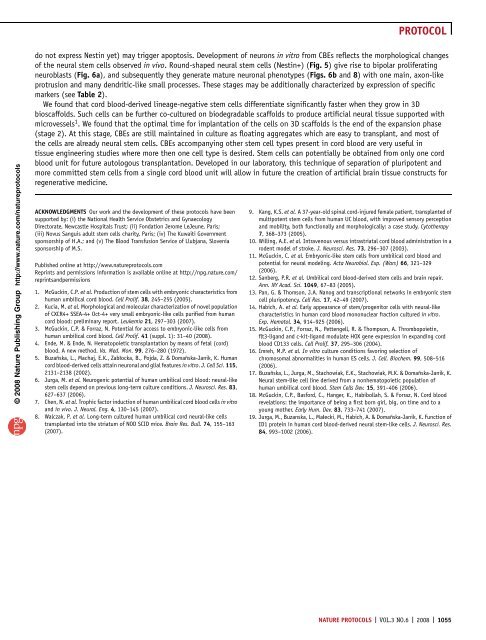Culture of embryonic-like stem cells from human
Culture of embryonic-like stem cells from human
Culture of embryonic-like stem cells from human
Create successful ePaper yourself
Turn your PDF publications into a flip-book with our unique Google optimized e-Paper software.
© 2008<br />
Nature<br />
Publishing<br />
Group<br />
http:<br />
/ / www.<br />
nature.<br />
com/<br />
natureprotocols<br />
do not express Nestin yet) may trigger apoptosis. Development <strong>of</strong> neurons in vitro <strong>from</strong> CBEs reflects the morphological changes<br />
<strong>of</strong> the neural <strong>stem</strong> <strong>cells</strong> observed in vivo. Round-shaped neural <strong>stem</strong> <strong>cells</strong> (Nestin+) (Fig. 5) give rise to bipolar proliferating<br />
neuroblasts (Fig. 6a), and subsequently they generate mature neuronal phenotypes (Figs. 6b and 8) withonemain,axon-<strong>like</strong><br />
protrusion and many dendritic-<strong>like</strong> small processes. These stages may be additionally characterized by expression <strong>of</strong> specific<br />
markers (see Table 2).<br />
We found that cord blood-derived lineage-negative <strong>stem</strong> <strong>cells</strong> differentiate significantly faster when they grow in 3D<br />
bioscaffolds. Such <strong>cells</strong> can be further co-cultured on biodegradable scaffolds to produce artificial neural tissue supported with<br />
microvessels 1 . We found that the optimal time for implantation <strong>of</strong> the <strong>cells</strong> on 3D scaffolds is the end <strong>of</strong> the expansion phase<br />
(stage 2). At this stage, CBEs are still maintained in culture as floating aggregates which are easy to transplant, and most <strong>of</strong><br />
the <strong>cells</strong> are already neural <strong>stem</strong> <strong>cells</strong>. CBEs accompanying other <strong>stem</strong> cell types present in cord blood are very useful in<br />
tissue engineering studies where more then one cell type is desired. Stem <strong>cells</strong> can potentially be obtained <strong>from</strong> only one cord<br />
blood unit for future autologous transplantation. Developed in our laboratory, this technique <strong>of</strong> separation <strong>of</strong> pluripotent and<br />
more committed <strong>stem</strong> <strong>cells</strong> <strong>from</strong> a single cord blood unit will allow in future the creation <strong>of</strong> artificial brain tissue constructs for<br />
regenerative medicine.<br />
ACKNOWLEDGMENTS Our work and the development <strong>of</strong> these protocols have been<br />
supported by: (i) the National Health Service Obstetrics and Gynaecology<br />
Directorate, Newcastle Hospitals Trust; (ii) Fondation Jerome LeJeune, Paris;<br />
(iii) Novus Sanguis adult <strong>stem</strong> <strong>cells</strong> charity, Paris; (iv) The Kuwaiti Government<br />
sponsorship <strong>of</strong> H.A.; and (v) The Blood Transfusion Service <strong>of</strong> Llubjana, Slovenia<br />
sponsorship <strong>of</strong> M.S.<br />
Published online at http://www.natureprotocols.com<br />
Reprints and permissions information is available online at http://npg.nature.com/<br />
reprintsandpermissions<br />
1. McGuckin, C.P. et al. Production <strong>of</strong> <strong>stem</strong> <strong>cells</strong> with <strong>embryonic</strong> characteristics <strong>from</strong><br />
<strong>human</strong> umbilical cord blood. Cell Prolif. 38, 245–255 (2005).<br />
2. Kucia, M. et al. Morphological and molecular characterization <strong>of</strong> novel population<br />
<strong>of</strong> CXCR4+ SSEA-4+ Oct-4+ very small <strong>embryonic</strong>-<strong>like</strong> <strong>cells</strong> purified <strong>from</strong> <strong>human</strong><br />
cord blood: preliminary report. Leukemia 21, 297–303 (2007).<br />
3. McGuckin, C.P. & Forraz, N. Potential for access to <strong>embryonic</strong>-<strong>like</strong> <strong>cells</strong> <strong>from</strong><br />
<strong>human</strong> umbilical cord blood. Cell Prolif. 41 (suppl. 1): 31–40 (2008).<br />
4. Ende, M. & Ende, N. Hematopoietic transplantation by means <strong>of</strong> fetal (cord)<br />
blood. A new method. Va. Med. Mon. 99, 276–280 (1972).<br />
5. Buzañska, L., Machaj, E.K., Zab"ocka, B., Pojda, Z. & Domañska-Janik, K. Human<br />
cord blood-derived <strong>cells</strong> attain neuronal and glial features in vitro. J. Cell Sci. 115,<br />
2131–2138 (2002).<br />
6. Jurga, M. et al. Neurogenic potential <strong>of</strong> <strong>human</strong> umbilical cord blood: neural-<strong>like</strong><br />
<strong>stem</strong> <strong>cells</strong> depend on previous long-term culture conditions. J. Neurosci. Res. 83,<br />
627–637 (2006).<br />
7. Chen, N. et al. Trophic factor induction <strong>of</strong> <strong>human</strong> umbilical cord blood <strong>cells</strong> in vitro<br />
and in vivo. J. Neural. Eng. 4, 130–145 (2007).<br />
8. Walczak, P. et al. Long-term cultured <strong>human</strong> umbilical cord neural-<strong>like</strong> <strong>cells</strong><br />
transplanted into the striatum <strong>of</strong> NOD SCID mice. Brain Res. Bull. 74, 155–163<br />
(2007).<br />
PROTOCOL<br />
9. Kang, K.S. et al. A 37-year-old spinal cord-injured female patient, transplanted <strong>of</strong><br />
multipotent <strong>stem</strong> <strong>cells</strong> <strong>from</strong> <strong>human</strong> UC blood, with improved sensory perception<br />
and mobility, both functionally and morphologically: a case study. Cytotherapy<br />
7, 368–373 (2005).<br />
10. Willing, A.E. et al. Intravenous versus intrastriatal cord blood administration in a<br />
rodent model <strong>of</strong> stroke. J. Neurosci. Res. 73, 296–307 (2003).<br />
11. McGuckin, C. et al. Embryonic-<strong>like</strong> <strong>stem</strong> <strong>cells</strong> <strong>from</strong> umbilical cord blood and<br />
potential for neural modeling. Acta Neurobiol. Exp. (Wars) 66, 321–329<br />
(2006).<br />
12. Sanberg, P.R. et al. Umbilical cord blood-derived <strong>stem</strong> <strong>cells</strong> and brain repair.<br />
Ann. NY Acad. Sci. 1049, 67–83 (2005).<br />
13. Pan, G. & Thomson, J.A. Nanog and transcriptional networks in <strong>embryonic</strong> <strong>stem</strong><br />
cell pluripotency. Cell Res. 17, 42–49 (2007).<br />
14. Habich, A. et al. Early appearance <strong>of</strong> <strong>stem</strong>/progenitor <strong>cells</strong> with neural-<strong>like</strong><br />
characteristics in <strong>human</strong> cord blood mononuclear fraction cultured in vitro.<br />
Exp. Hematol. 34, 914–925 (2006).<br />
15. McGuckin, C.P., Forraz, N., Pettengell, R. & Thompson, A. Thrombopoietin,<br />
flt3-ligand and c-kit-ligand modulate HOX gene expression in expanding cord<br />
blood CD133 <strong>cells</strong>. Cell Prolif. 37, 295–306 (2004).<br />
16. Imreh, M.P. et al. In vitro culture conditions favoring selection <strong>of</strong><br />
chromosomal abnormalities in <strong>human</strong> ES <strong>cells</strong>. J. Cell. Biochem. 99, 508–516<br />
(2006).<br />
17. Buzañska, L., Jurga, M., Stachowiak, E.K., Stachowiak, M.K. & Domañska-Janik, K.<br />
Neural <strong>stem</strong>-<strong>like</strong> cell line derived <strong>from</strong> a nonhematopoietic population <strong>of</strong><br />
<strong>human</strong> umbilical cord blood. Stem Cells Dev. 15, 391–406 (2006).<br />
18. McGuckin, C.P., Basford, C., Hanger, K., Habibollah, S. & Forraz, N. Cord blood<br />
revelations: the importance <strong>of</strong> being a first born girl, big, on time and to a<br />
young mother. Early Hum. Dev. 83, 733–741 (2007).<br />
19. Jurga, M., Buzanska, L., Ma"ecki, M., Habich, A. & Domañska-Janik, K. Function <strong>of</strong><br />
ID1 protein in <strong>human</strong> cord blood-derived neural <strong>stem</strong>-<strong>like</strong> <strong>cells</strong>. J. Neurosci. Res.<br />
84, 993–1002 (2006).<br />
NATURE PROTOCOLS | VOL.3 NO.6 | 2008 | 1055













